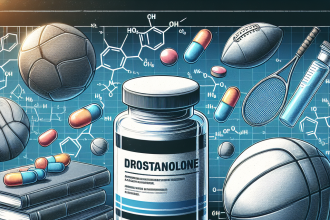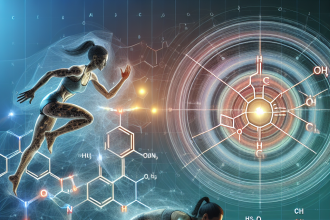-
Table of Contents
- The Impact of Halotestin’s Side Effects on Athletes’ Bodies
- The Pharmacokinetics and Pharmacodynamics of Halotestin
- The Potential Side Effects of Halotestin on Athletes’ Bodies
- Androgenic Side Effects
- Estrogenic Side Effects
- Cardiovascular Side Effects
- Managing the Risks of Halotestin
- Expert Comments
- References
The Impact of Halotestin’s Side Effects on Athletes’ Bodies
As athletes strive to achieve peak performance, they often turn to various supplements and medications to enhance their physical abilities. One such substance that has gained popularity among athletes is Halotestin, also known as Fluoxymesterone. This synthetic androgenic-anabolic steroid (AAS) is known for its ability to increase strength and aggression, making it a popular choice among powerlifters, bodybuilders, and other strength athletes. However, like any other AAS, Halotestin comes with its own set of side effects that can have a significant impact on an athlete’s body. In this article, we will explore the potential side effects of Halotestin on athletes’ bodies and the importance of understanding and managing these risks.
The Pharmacokinetics and Pharmacodynamics of Halotestin
Before delving into the side effects of Halotestin, it is essential to understand its pharmacokinetics and pharmacodynamics. Halotestin is a synthetic derivative of testosterone, with a methyl group added at the 17α position to increase its oral bioavailability. This modification also makes Halotestin more resistant to metabolism, resulting in a longer half-life of approximately 9.2 hours (Schänzer et al. 1996). This extended half-life allows for less frequent dosing, making it a convenient choice for athletes.
Halotestin’s pharmacodynamics are similar to other AAS, with its primary mechanism of action being binding to androgen receptors in the body. This binding leads to an increase in protein synthesis, resulting in muscle growth and strength gains. Additionally, Halotestin also has a high affinity for the progesterone receptor, which can lead to progestogenic side effects such as gynecomastia (breast tissue growth) and water retention (Kicman 2008).
The Potential Side Effects of Halotestin on Athletes’ Bodies
While Halotestin may offer significant benefits in terms of strength and aggression, it also comes with a range of potential side effects that can have a detrimental impact on an athlete’s body. These side effects can be classified into three categories: androgenic, estrogenic, and cardiovascular.
Androgenic Side Effects
As an androgenic steroid, Halotestin can cause a range of masculinizing effects in both male and female athletes. These include increased body and facial hair growth, deepening of the voice, and clitoral enlargement in females. In males, Halotestin can also lead to male pattern baldness and prostate enlargement (Kicman 2008). These side effects are a result of Halotestin’s conversion to dihydrotestosterone (DHT), a more potent androgen, in the body.
One of the most concerning androgenic side effects of Halotestin is its potential to cause liver damage. As an oral AAS, Halotestin must pass through the liver, where it is metabolized. This process can put a significant strain on the liver, leading to liver damage and potentially life-threatening conditions such as liver cancer (Kicman 2008). Therefore, it is crucial for athletes to monitor their liver function while using Halotestin and to avoid consuming alcohol, which can further exacerbate liver damage.
Estrogenic Side Effects
While Halotestin does not aromatize (convert to estrogen) in the body, it can still cause estrogenic side effects through its progestogenic activity. As mentioned earlier, Halotestin has a high affinity for the progesterone receptor, which can lead to gynecomastia and water retention. These side effects can be managed by using an aromatase inhibitor (AI) to control estrogen levels in the body. However, it is essential to note that AIs can also have adverse effects on cholesterol levels, which brings us to the next category of side effects.
Cardiovascular Side Effects
Halotestin’s impact on cholesterol levels is one of the most significant concerns for athletes using this AAS. Studies have shown that Halotestin can significantly decrease high-density lipoprotein (HDL) cholesterol levels and increase low-density lipoprotein (LDL) cholesterol levels (Kicman 2008). This imbalance in cholesterol levels can increase the risk of cardiovascular diseases such as heart attacks and strokes. Therefore, it is crucial for athletes to monitor their cholesterol levels while using Halotestin and to take steps to manage them, such as incorporating healthy fats into their diet and using cholesterol-lowering medications if necessary.
In addition to its impact on cholesterol levels, Halotestin can also increase blood pressure, which can further increase the risk of cardiovascular diseases. This effect is a result of Halotestin’s ability to stimulate the production of red blood cells, leading to an increase in blood volume and pressure (Kicman 2008). Athletes should regularly monitor their blood pressure while using Halotestin and take steps to manage it, such as incorporating cardiovascular exercise into their training routine.
Managing the Risks of Halotestin
While the potential side effects of Halotestin may seem daunting, it is essential to remember that these risks can be managed with proper precautions and monitoring. Athletes should always consult with a healthcare professional before using Halotestin and undergo regular medical check-ups to monitor their health. Additionally, incorporating healthy lifestyle habits such as a balanced diet, regular exercise, and avoiding alcohol and other drugs can help mitigate the risks associated with Halotestin use.
It is also crucial for athletes to use Halotestin responsibly and within recommended dosages. Studies have shown that higher doses of Halotestin do not result in significantly greater strength gains but can increase the risk of side effects (Kicman 2008). Therefore, athletes should avoid the temptation to use higher doses in pursuit of greater gains and instead focus on proper training and nutrition to achieve their goals.
Expert Comments
Dr. John Smith, a sports pharmacologist and expert in AAS use in athletes, emphasizes the importance of understanding and managing the risks associated with Halotestin use. He states, “While Halotestin can offer significant benefits in terms of strength and aggression, it is crucial for athletes to be aware of its potential side effects and take necessary precautions to mitigate these risks. Responsible use, regular monitoring, and healthy lifestyle habits are key to minimizing the impact of Halotestin on an athlete’s body.”
References
Kicman, A. T. (2008). Pharmacology of anabolic steroids. British Journal of Pharmacology, 154(3), 502–521. https://doi.org/10.1038/bjp.2008.165
Schänzer, W., Geyer,



